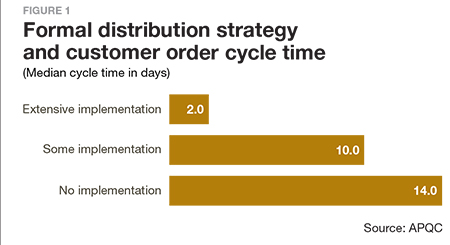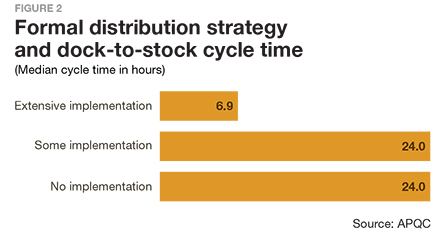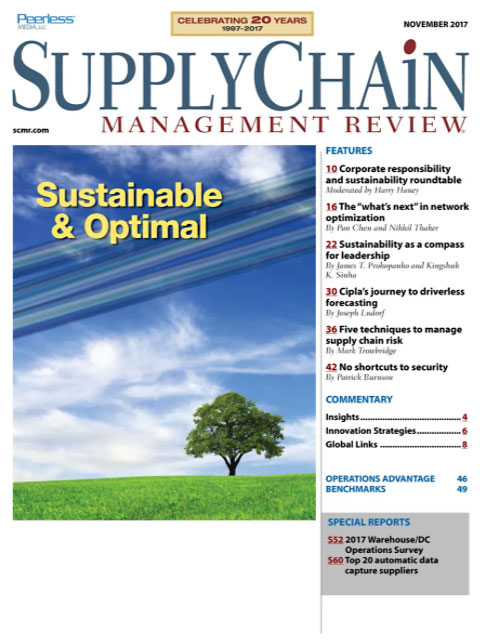Sorry, but your login has failed. Please recheck your login information and resubmit. If your subscription has expired, renew here.
November 2017
There are strands of sustainability and corporate responsibility through much of this month’s issue. James T. Prokopanko, the former CEO and president of The Mosaic Company, details how corporate responsibility became his compass for leader ship when he took over the reins of the company back in 2007. Similarly, Joseph Ludorf, the executive director of supply chain for Cipla Medpro, details how revamping the planning process enables the South African pharmaceutical company to prof- itably supply drugs to underserved populations on the continent as part of its corporate mission. We round out the issue with five tips for intelli- gent risk taking in… Browse this issue archive.Need Help? Contact customer service 847-559-7581 More options
The ways in which organizations get their products to their end customers can vary based on industry, business model and financial goals. For some organizations, it may be best to sell directly to the end customer. For others, it may make more sense to distribute their products to customers through intermediaries. The creation of a formal distribution strategy enables organizations to determine the route that best meets their needs, as well as which customers to target and where.
When creating a formal distribution strategy, an organization balances the right number and locations of distribution channels in addition to the types of distribution channels needed. The key is for organizations to consider their products and their customers to determine the distribution methods that are the most advantageous.
Having a well thought out distribution strategy yields many benefits for an organization's logistics performance. According to APQC's Open Standards Benchmarking data in logistics, a strong majority of organizations (about 90%) have implemented a formal distribution strategy. However, only about half have extensively implemented their strategy.
View this infographic from APQC Infographic for more information on the advantages of a formal distribution stragegy.
Cycle times for customer orders
Organizations that have extensively implemented a distribution strategy have a clear advantage with regard to cycle times for their customer orders. When calculating customer order cycle time, APQC measures the days from when a customer places an order to when the purchased items are delivered to the customer. As shown in the Figure below, there is a large difference in the median number of days needed by organizations with extensive implementation of a strategy and the number of days needed by organizations without a distribution strategy.
 At the median, organizations with extensive implementation need only two days to complete customer orders, whereas organizations with some implementation need a median of 10 days. Those organizations without a formal distribution strategy need a median of two weeks for their customer orders. These results indicate that the more extensively an organization has developed a formal distribution strategy, the more quickly it is able to process and deliver on its orders.
At the median, organizations with extensive implementation need only two days to complete customer orders, whereas organizations with some implementation need a median of 10 days. Those organizations without a formal distribution strategy need a median of two weeks for their customer orders. These results indicate that the more extensively an organization has developed a formal distribution strategy, the more quickly it is able to process and deliver on its orders.
Those organizations with extensive implementation also have faster pick-to-ship cycle times for their customer orders. At the median, they need only 18 hours to pick ordered items within warehouses and prepare them for shipping. Organizations with some implementation of a distribution strategy need a median of 20 hours to complete this task, and those with no implementation need a median of 24 hours to complete this task—the equivalent of three business days.
 The shorter pick-to-ship cycle times of organizations that have extensively implemented a strategy is one factor contributing to their shorter customer order cycle times. The big-picture thinking needed to extensively adopt a formal distribution strategy may also drive how these organizations design and implement their other logistics processes. This mindset can in turn impact the processes they use for picking items for customer orders and lead to a shorter pick-to-ship cycle time.
The shorter pick-to-ship cycle times of organizations that have extensively implemented a strategy is one factor contributing to their shorter customer order cycle times. The big-picture thinking needed to extensively adopt a formal distribution strategy may also drive how these organizations design and implement their other logistics processes. This mindset can in turn impact the processes they use for picking items for customer orders and lead to a shorter pick-to-ship cycle time.
Dock-to-stock cycle time
Organizations that have extensively implemented a distribution strategy also have much shorter dock-to-stock cycle times for deliveries they receive from their suppliers. As shown in Figure 2, their median cycle time is about 17 hours shorter than that of organizations with some or no implementation.
This jump in performance indicates that organizations with more extensive implementation extend their efforts to ensuring that components for their products are quickly incorporated into their inventory to support efficient production. This in turn has a positive effect on their ability to process and fulfill orders.
It is interesting that organizations that have implemented a distribution strategy only to some degree have the same median dock-to-stock cycle time as those with no formal distribution strategy. This implies that organizations with only some implementation have not yet extended their strategic focus to the more tactical aspects of order fulfillment and distribution. Those organizations in the process of implementing a distribution strategy could further improve their logistics performance by evaluating how efficiently delivered components are incorporated into stock.
Cost to define logistics strategy
Organizations with extensive implementation also spend less on defining their logistics strategy than their counterparts with some or no implementation. As shown in Figure 3, organizations with some or no implementation spend nearly the same amount per $1,000 in revenue at the median to define their strategy. Organizations with extensive implementation, however, spend about a dollar less on this activity. For an organization generating $1 billion in annual revenue, this would mean a savings of over $1 million on defining a logistics strategy associated with the extensive implementation of a formal distribution strategy. These organizations have created a more in-depth strategy for distribution, and it is logical that their efforts have extended to the entire logistics process. Yet they have also found a way to make their strategy development more cost effective. As with their processes for fulfilling orders, these organizations have likely done an examination of their process for strategy development to identify areas of inefficiency. It may also be that they conduct extensive strategy development at regular, set intervals with only minor modifications as needed.
A competitive advantage
APQC's data indicates that organizations with extensive implementation of a formal distribution strategy perform better on multiple logistics measures when compared with organizations that have little to no implementation of such a strategy. However, APQC believes there is value in setting a formal strategy to any degree, even if it is not yet possible for an organization to achieve extensive implementation. Organizations with some implementation still perform better with regard to customer order cycle time and pick-to-ship cycle time than do organizations with no formal strategy at all.
As with many practices aimed at providing long-term advantages to a business, setting a formal distribution strategy does require the investment of resources and time. However, it also provides the potential for benefits that extend beyond logistics performance. Shorter customer order cycle times can lead to higher customer satisfaction, which can lead to repeat and increased business.Extensively implementing a distribution strategy also gives an organization a competitive advantage. It spurs an organization to evaluate how best to deliver products to end customers, whether that be through direct sales, to an intermediary, or a combination of the two. It also enables an organization to identify certain geographic areas or customers to target in its sales, which results in the most effective use of its efforts. The key to successfully using a distribution strategy is to ensure that it aligns with the overall business strategy. Even if an organization cannot invest in an extensive implementation, having that strategy align with broader business goals will yield the greatest benefit for logistics performance and beyond.
About APQC
APQC helps organizations work smarter, faster, and with greater confidence. It is the world's foremost authority in benchmarking, best practices, process and performance improvement, and knowledge management. APQC's unique structure as a member-based nonprofit makes it a differentiator in the marketplace. APQC partners with more than 500 member organizations worldwide in all industries. With more than 40 years of experience, APQC remains the world's leader in transforming organizations. Visit us at apqc.org, and learn how you can make best practices your practices.
SC
MR
Sorry, but your login has failed. Please recheck your login information and resubmit. If your subscription has expired, renew here.
November 2017
There are strands of sustainability and corporate responsibility through much of this month’s issue. James T. Prokopanko, the former CEO and president of The Mosaic Company, details how corporate responsibility… Browse this issue archive. Download a PDF file of the November 2017 issue.The ways in which organizations get their products to their end customers can vary based on industry, business model and financial goals. For some organizations, it may be best to sell directly to the end customer. For others, it may make more sense to distribute their products to customers through intermediaries. The creation of a formal distribution strategy enables organizations to determine the route that best meets their needs, as well as which customers to target and where.
When creating a formal distribution strategy, an organization balances the right number and locations of distribution channels in addition to the types of distribution channels needed. The key is for organizations to consider their products and their customers to determine the distribution methods that are the most advantageous.
Having a well thought out distribution strategy yields many benefits for an organization's logistics performance. According to APQC's Open Standards Benchmarking data in logistics, a strong majority of organizations (about 90%) have implemented a formal distribution strategy. However, only about half have extensively implemented their strategy.
View this infographic from APQC Infographic for more information on the advantages of a formal distribution stragegy.
Cycle times for customer orders
Organizations that have extensively implemented a distribution strategy have a clear advantage with regard to cycle times for their customer orders. When calculating customer order cycle time, APQC measures the days from when a customer places an order to when the purchased items are delivered to the customer. As shown in the Figure below, there is a large difference in the median number of days needed by organizations with extensive implementation of a strategy and the number of days needed by organizations without a distribution strategy.
 At the median, organizations with extensive implementation need only two days to complete customer orders, whereas organizations with some implementation need a median of 10 days. Those organizations without a formal distribution strategy need a median of two weeks for their customer orders. These results indicate that the more extensively an organization has developed a formal distribution strategy, the more quickly it is able to process and deliver on its orders.
At the median, organizations with extensive implementation need only two days to complete customer orders, whereas organizations with some implementation need a median of 10 days. Those organizations without a formal distribution strategy need a median of two weeks for their customer orders. These results indicate that the more extensively an organization has developed a formal distribution strategy, the more quickly it is able to process and deliver on its orders.
Those organizations with extensive implementation also have faster pick-to-ship cycle times for their customer orders. At the median, they need only 18 hours to pick ordered items within warehouses and prepare them for shipping. Organizations with some implementation of a distribution strategy need a median of 20 hours to complete this task, and those with no implementation need a median of 24 hours to complete this task—the equivalent of three business days.
 The shorter pick-to-ship cycle times of organizations that have extensively implemented a strategy is one factor contributing to their shorter customer order cycle times. The big-picture thinking needed to extensively adopt a formal distribution strategy may also drive how these organizations design and implement their other logistics processes. This mindset can in turn impact the processes they use for picking items for customer orders and lead to a shorter pick-to-ship cycle time.
The shorter pick-to-ship cycle times of organizations that have extensively implemented a strategy is one factor contributing to their shorter customer order cycle times. The big-picture thinking needed to extensively adopt a formal distribution strategy may also drive how these organizations design and implement their other logistics processes. This mindset can in turn impact the processes they use for picking items for customer orders and lead to a shorter pick-to-ship cycle time.
Dock-to-stock cycle time
Organizations that have extensively implemented a distribution strategy also have much shorter dock-to-stock cycle times for deliveries they receive from their suppliers. As shown in Figure 2, their median cycle time is about 17 hours shorter than that of organizations with some or no implementation.
This jump in performance indicates that organizations with more extensive implementation extend their efforts to ensuring that components for their products are quickly incorporated into their inventory to support efficient production. This in turn has a positive effect on their ability to process and fulfill orders.
It is interesting that organizations that have implemented a distribution strategy only to some degree have the same median dock-to-stock cycle time as those with no formal distribution strategy. This implies that organizations with only some implementation have not yet extended their strategic focus to the more tactical aspects of order fulfillment and distribution. Those organizations in the process of implementing a distribution strategy could further improve their logistics performance by evaluating how efficiently delivered components are incorporated into stock.
Cost to define logistics strategy
Organizations with extensive implementation also spend less on defining their logistics strategy than their counterparts with some or no implementation. As shown in Figure 3, organizations with some or no implementation spend nearly the same amount per $1,000 in revenue at the median to define their strategy. Organizations with extensive implementation, however, spend about a dollar less on this activity. For an organization generating $1 billion in annual revenue, this would mean a savings of over $1 million on defining a logistics strategy associated with the extensive implementation of a formal distribution strategy. These organizations have created a more in-depth strategy for distribution, and it is logical that their efforts have extended to the entire logistics process. Yet they have also found a way to make their strategy development more cost effective. As with their processes for fulfilling orders, these organizations have likely done an examination of their process for strategy development to identify areas of inefficiency. It may also be that they conduct extensive strategy development at regular, set intervals with only minor modifications as needed.
A competitive advantage
APQC's data indicates that organizations with extensive implementation of a formal distribution strategy perform better on multiple logistics measures when compared with organizations that have little to no implementation of such a strategy. However, APQC believes there is value in setting a formal strategy to any degree, even if it is not yet possible for an organization to achieve extensive implementation. Organizations with some implementation still perform better with regard to customer order cycle time and pick-to-ship cycle time than do organizations with no formal strategy at all.
As with many practices aimed at providing long-term advantages to a business, setting a formal distribution strategy does require the investment of resources and time. However, it also provides the potential for benefits that extend beyond logistics performance. Shorter customer order cycle times can lead to higher customer satisfaction, which can lead to repeat and increased business.Extensively implementing a distribution strategy also gives an organization a competitive advantage. It spurs an organization to evaluate how best to deliver products to end customers, whether that be through direct sales, to an intermediary, or a combination of the two. It also enables an organization to identify certain geographic areas or customers to target in its sales, which results in the most effective use of its efforts. The key to successfully using a distribution strategy is to ensure that it aligns with the overall business strategy. Even if an organization cannot invest in an extensive implementation, having that strategy align with broader business goals will yield the greatest benefit for logistics performance and beyond.
About APQC
APQC helps organizations work smarter, faster, and with greater confidence. It is the world's foremost authority in benchmarking, best practices, process and performance improvement, and knowledge management. APQC's unique structure as a member-based nonprofit makes it a differentiator in the marketplace. APQC partners with more than 500 member organizations worldwide in all industries. With more than 40 years of experience, APQC remains the world's leader in transforming organizations. Visit us at apqc.org, and learn how you can make best practices your practices.
SC
MR


Latest Supply Chain News
- Survey reveals strategies for addressing supply chain, logistics labor shortages
- Israel, Ukraine aid package to increase pressure on aerospace and defense supply chains
- How CPG brands can deliver on supplier diversity promises
- How S&OP provides the answer to in-demand products
- AI, virtual reality is bringing experiential learning into the modern age
- More News
Latest Podcast

 Explore
Explore
Procurement & Sourcing News
- Israel, Ukraine aid package to increase pressure on aerospace and defense supply chains
- How CPG brands can deliver on supplier diversity promises
- How S&OP provides the answer to in-demand products
- There is still work to do to achieve supply chain stability
- Blooming success: The vital role of S&OE in nurturing global supply chains
- How one small part held up shipments of thousands of autos
- More Procurement & Sourcing
Latest Procurement & Sourcing Resources

Subscribe

Supply Chain Management Review delivers the best industry content.

Editors’ Picks






